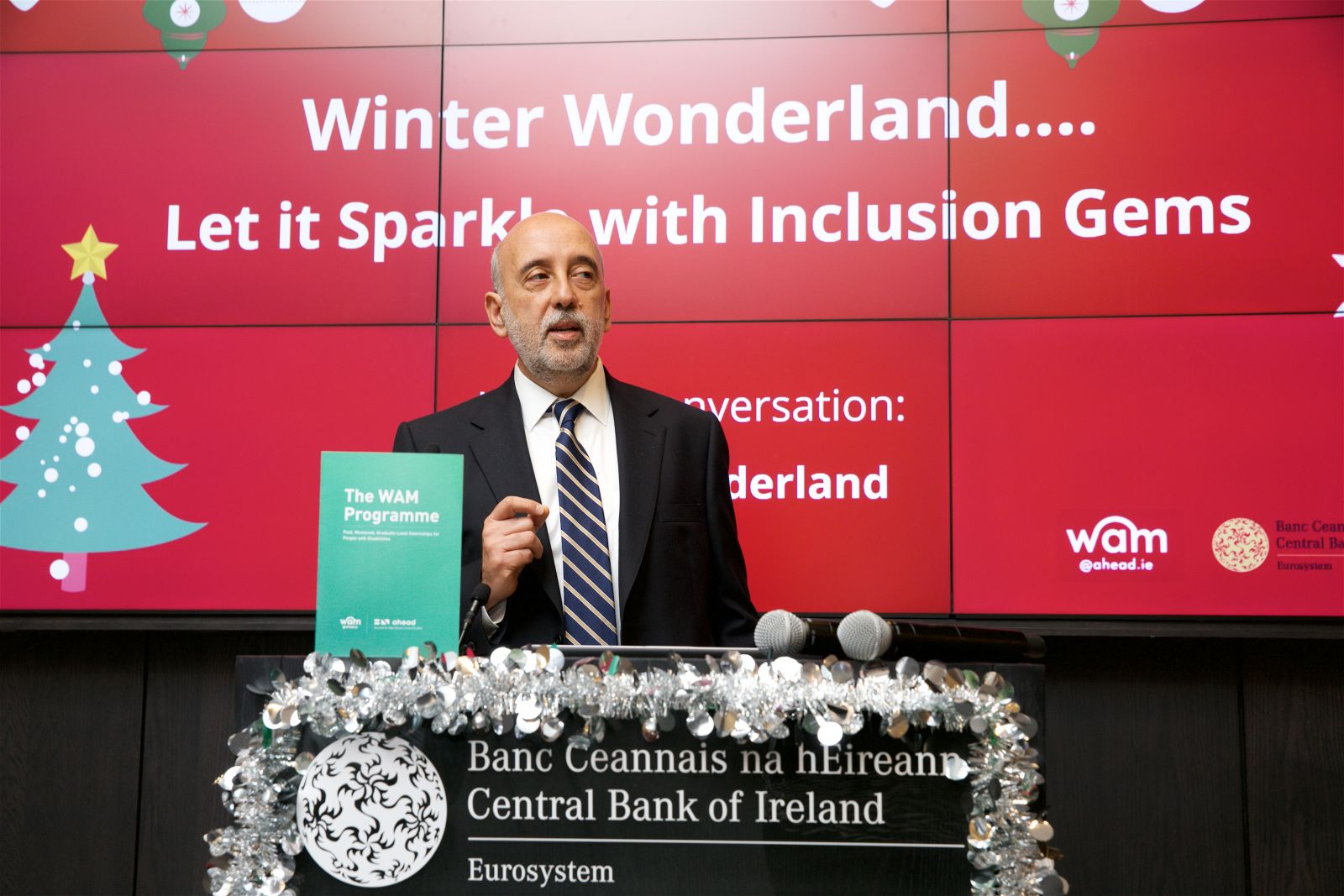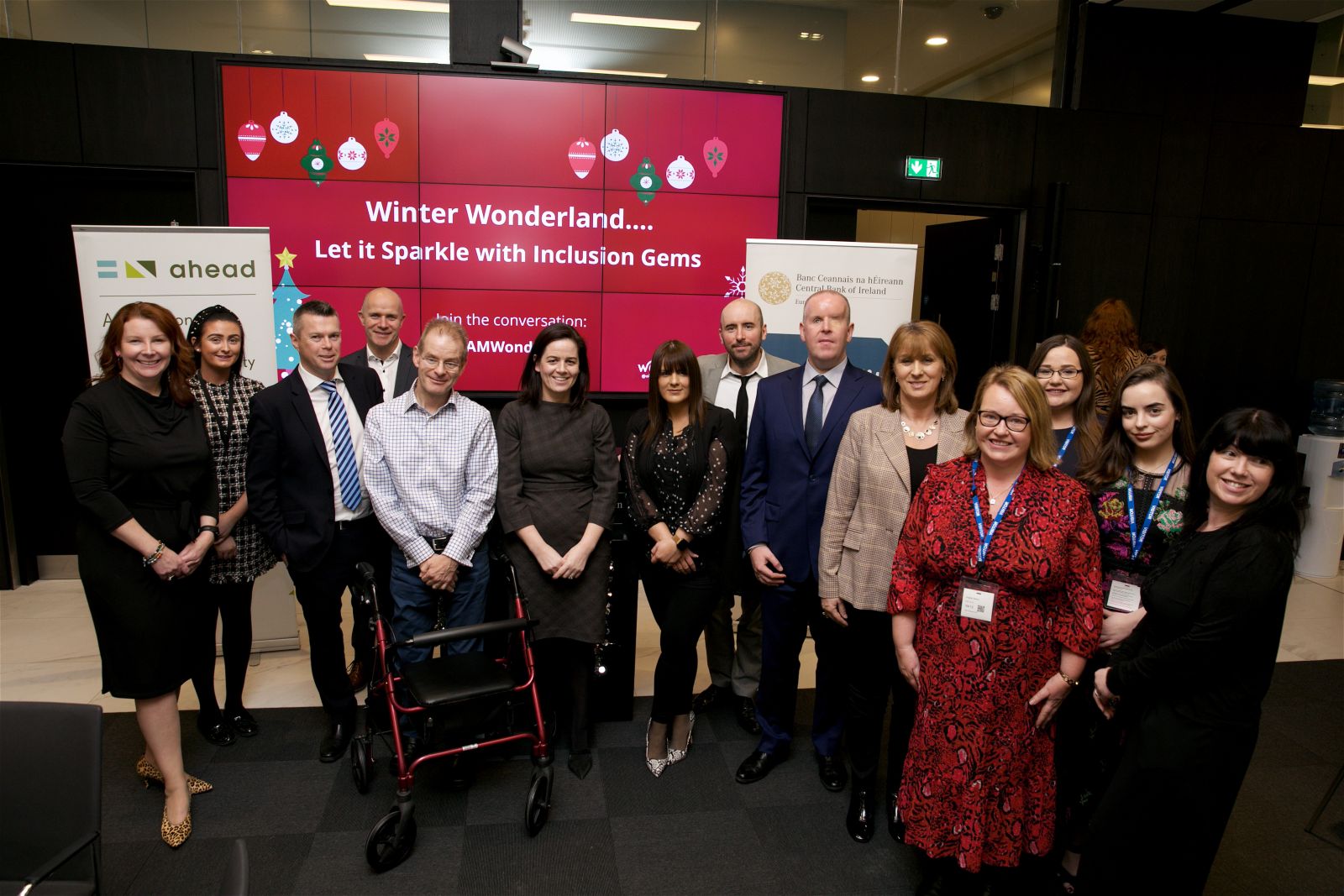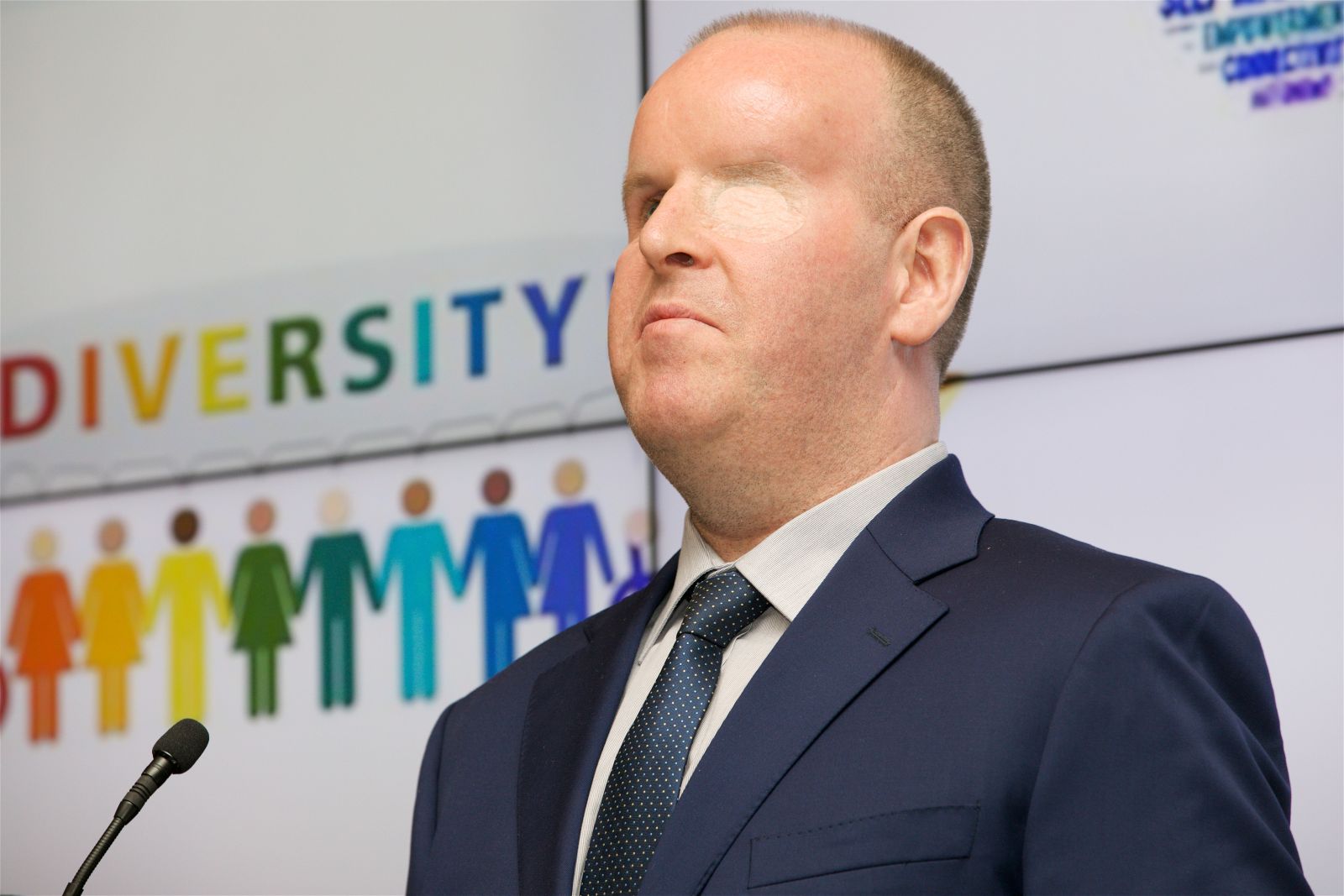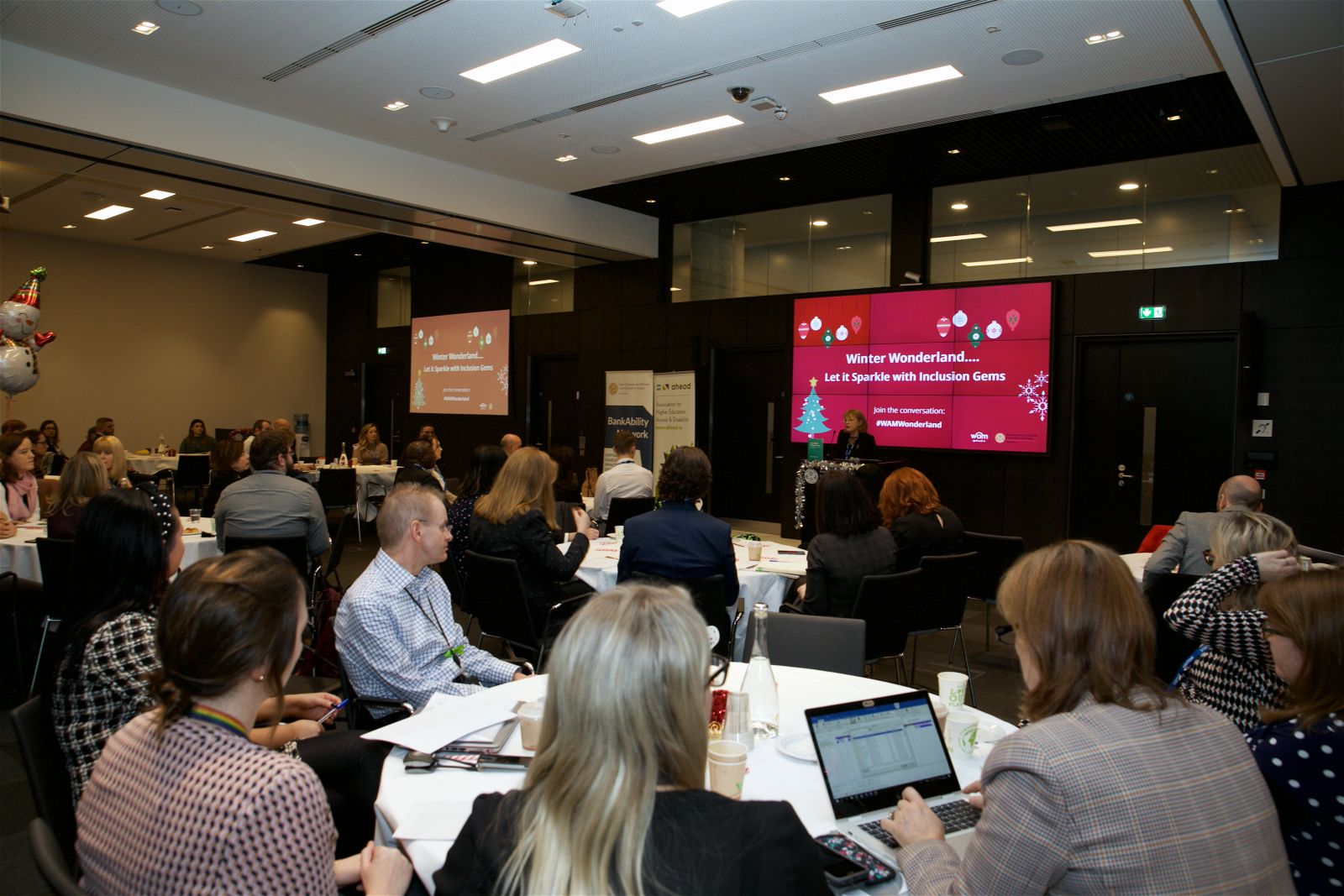WAM Wonderland Sparkled with Inclusion Gems! Recommendations for the creation of more diverse and inclusive working environments and recruitment methods
Introduction
The WAM Programme, which is funded by the Department of Employment Affairs and Social Protection (DEASP) is an initiative of AHEAD established in 2005 with the central objective of widening access to mainstream employment for graduates. Participating employers collaborate with WAM to offer graduates with disabilities a paid and mentored graduate internship for a minimum of 6 months; recently we have been increasingly working with our partners to ring-fence roles within their graduate programmes specifically for graduates on our database.
Developing WAM partner involvement
WAM hosts a number of employer training events each year on a range of topics relating to disability in the workplace. In December 2019, WAM invited 12 employers and the DEASP to host tables to explore their respective disability/access network within their organisation and to exchange best practice in relation to diversity and inclusion initiatives. The purpose of this event was to begin to learn how to channel the collective experience, knowledge and resources of all the employers present to help shift the wider culture of employment in Ireland to a more inclusive one that provides equal opportunities for all.
At this event, which attracted more than 100 attendees, members of AHEAD staff took notes from conversations at each table and have collated this article identifying the key issues and recommendations for best practice in the creation of more diverse and inclusive working environments from the expertise, information, and experiences shared on the day.
The table hosts were:
- Bank of America
- Bank of Ireland
- Central Bank (who kindly supported and hosted the event)
- Citi
- Dell Technologies
- Deutsche Bank
- Department of Employment Affairs and Social Protection
- Enterprise Rent-A-Car
- ESB
- Irish Life
- NTMA – National Treasury Management Agency
- Public Appointments Service – PAS
- Salesforce
It was evident to all of us in AHEAD that diversity and inclusion (D&I) which includes disability, is increasingly becoming a point of focus in the corporate sphere. It was heartening to see the abundance of passion, energy, and commitment from the individuals present on the day. This was an indicator for us that things can only improve for the next generation of graduates with disabilities making the transition from education to employment. Graduates enter the workforce hoping to find an environment where they are respected for their differences and a culture that actively engages in removing barriers, giving them the opportunities they crave to show their best selves.

Gabriel Makhlouf - Governor of Central Bank of Ireland
Best practice recommendations on creating more diverse and inclusive working environments and recruitment methods
The following recommendations are presented, drawing on the collective experience, knowledge and resources of employers and AHEAD:
Initiatives must have a clear focus with thought to their sustainability
Diversity and Inclusion initiatives should not be a box-ticking exercise. To ensure this, a specific Diversity and Inclusion corporate strategy must be implemented with regular reports to the board for same. The importance of the inclusion of people with disabilities in the decision process in relation to measures that are taken is paramount.
Grassroots engagement and senior buy-in is recommended
Across the board, there was an agreement that grassroots engagement and senior management buy-in and involvement is essential in ensuring the success and sustainability of disability networks and initiatives. One of the companies mentioned that their CEO serves on their disability network team and cited this as being an important factor in enhancing awareness about the network, ensuring in its sustainability, and increasing its number of participants. A couple of other companies stressed the importance of getting senior buy-in with regard to access to necessary resources for disability networks and initiatives.
Diversity and Inclusion agendas must include information and set policy surrounding disclosure
There must be an awareness amongst employers that the choice to disclose or not, is always for the person with the disability to make. Not all disabilities are visible, and the existence and nature of a person’s disability does not have to be made known in the workplace should they not wish it. However, this raises another question where targets around disability are concerned; how to measure disability when it’s proving difficult to gather voluntary census on the subject. Employers were concerned that they could be unintentionally in breach of equality legislation (Employment Equality Acts 1998-2015) if disability is not disclosed. Irish equality legislation refers to the responsibility of both parties and makes it clear that the employer has a responsibility to foster disclosure by creating the space that makes it possible to disclose. If this is followed there is less need for concern as long as an employer can demonstrate it has made explicit and concrete steps to encourage disclosure from the recruitment stage onwards. For people with disabilities themselves, a decision not to disclose can result in an absence of accommodations that may be necessary if they are to perform optimally. If these are not put in place, potentially a person could be perceived as underperforming.
How can we encourage disclosure? Firstly, it is important to foster supportive and inclusive workplace environments where employees are not afraid to disclose a disability. Secondly, there was a general concern regarding how to advise graduates with disabilities on how to disclose when entering mainstream recruitment. Overall an inclusive, holistic view of recruitment was proving helpful and it is recommended that consideration be given as to how incoming employees can be accommodated. For example, including information about disclosure in induction packs with details of who to contact for more information in confidence.
It is important that there is an awareness amongst employees that inclusive work environments and practices benefit the entire organisation
A recurring theme amongst the organisations present was how important it was that people who don’t identify in typical diversity and inclusion groupings see themselves represented in the agenda for diversity and inclusion. Thus, all staff members should be aware that inclusive environments and employment practices are for and benefit everyone. All employees should be encouraged to achieve their individual potential. Diversity and inclusion is about raising everyone up and Universal Design principles on designing an environment that works for everyone are the tool with which we can achieve this.

Staff members from AHEAD with Central Bank BankAbility staff and guest speaker Tricia Smyth from Dell Technologies
Easing the transition from college to the workplace should be a priority
All transitions are difficult, and the transition from education to the working world is arguably one of the most daunting ones. For graduates with disabilities, there is an extra layer of anxiety surrounding this as many will have received accommodations and support in education and they may be unsure about whether they are entitled to in employment. This ties into disclosure: ensuring that every measure is taken in order that graduates with disabilities feel comfortable to disclose and to receive the accommodations they need in order for their workplace to be accessible for them. Upon disclosure, it's important that a structured conversation is had in order to ascertain what supports (reasonable accommodations) the graduate might need in the workplace. This is commonly known as a needs assessment.
Disability Awareness Training in organisations is paramount
Many of the barriers that people with disabilities face in an employment setting can be attributed to a lack of disability awareness amongst employers, including fellow employees. In this respect, Disability Awareness Training - either as part of general diversity training or (preferably) on its own - is an absolute necessity. It is advised that in-house training in this regard must take a top-down approach and start with managers; ideally being integrated into manager training. It is paramount that employees with disabilities feel there is an open line of communication between them and their manager. They should feel comfortable approaching their line manager to discuss any disability and the impact it has on them in a work context, without fear of being discriminated against or being met with a negative or paternalistic attitude. Disability Awareness Training must include reference to unconscious bias and privilege; it is important to encourage people to acknowledge both without burdening them with associated guilt. Igniting positive attitudinal change should be the foundation of any Disability Awareness Training. The Department of Employment Affairs and Social Protection’s Disability Awareness Support Scheme provides funding for private sector employers to arrange and pay for disability awareness training for staff who work with a colleague who has a disability.
With regard to specific disability-related topics, neurodiversity was the one that was mentioned most amongst the organisations as being important to provide training on. Neurodiversity being used as an umbrella term to describe disabilities such as dyslexia, dyspraxia, ADHD, OCD, mental health etc. These individuals have differences in the way they think and interact with the world, including the workplace.
Highlight the strong business case for hiring people with disabilities
The recent European Commission Country Report for Ireland 2019 found that Ireland has one of the lowest employment rates for people with disabilities in the EU (26.2% compared to 48.1% in the EU as a whole in 2017) and one of the highest gaps between people with and without disabilities in employment (45.1 percentage points). As Antoinette McDermott, Regulatory Diversity and Inclusion Lead from Central Bank said in her speech at the event
‘not everybody understands the value of diversity’. In relation to people with disabilities, there is often a view that ‘these are people we service, not people we work with’.
Certainly, the statistics above indicate that Ireland is guilty of this insular outlook. It is so important to highlight the strong professional capabilities that people with disabilities can bring to an organisation and also the many ways having employees with disabilities can benefit an organisation as a whole. There is a need to move away from the paternalistic view of hiring people with disabilities as a CSR initiative or from a charity model, rather we should focus on highlighting the strong business case for hiring people with disabilities, which include (but are not limited to):
- Diversity in employees fosters diversity of thought. Neurodiverse individuals specifically can have impressive and unique approaches that can be of great benefit to their team and company. People with disabilities can have unique insights from their own experiences.
- People with disabilities regularly exhibit a level of resilience and determination above that the average person.
- People with disabilities can have more experience of problem solving than the general population due to figuring out how to navigate the constant barriers that they may have to face daily.
- For customer service, it is great to have a range of cohorts represented in the company that the public can identify with. Representation is so important and organisations must be cognisant to incorporate the visuals of diversity in promotion and advertising. As Governor of Central Bank, Gabriel Makhlouf, said when welcoming attendees to the event: ‘organisations who reflect the society they work in, and work for, are stronger organisations’.
- Adaptations or accommodations made for an employee with disabilities will provide awareness and education for companies on what will work for their customers and the public too.
Engage in initiatives and programmes focused on increasing and promoting the employment of people with disabilities within your organisation
The majority of the companies present on the day work with the WAM Programme in placing graduates with disabilities. This was mentioned as a great benefit to promoting and facilitating increased hiring of people with disabilities. It was good to learn of the positive impact WAM graduates have made to these environments and teams.
Some other companies also mentioned the benefit of collaborating with other organisations in offering work placements or job shadow days to increase awareness and promote work opportunities. These organisations may be working with a targeted group such as those with mental health difficulties, who are blind or have autism.
Barriers at recruitment stage must be addressed and broken down
In order to get more people with disabilities into organisations, the recruitment process must be streamlined and accessible. When advertising for a position, AHEAD strongly recommends identifying the core competencies in the job specification. Care should be taken to make them as specific and detailed as possible. When looking at candidates focus on whether they match the core skills of this job specification. Also, care should be taken not to dismiss a candidate who may have gaps in their CV. There are many valid/unavoidable reasons why people, in particular individuals with a disability, may have these gaps. Employers discounting candidates on the basis of this can be a significant barrier faced in the recruitment process; it also means that companies are missing out on talent!
At the interview stage, it is always important to ask interviewees if they have any accessibility requirements and to liaise with disability organisations if there is uncertainty about how to implement these.
One recruitment method that is becoming increasingly prevalent and has proven to be inaccessible for many cohorts of people is online psychometric testing. Commercial tests are based on cohorts with statistical norms in a certain population and are therefore not going to provide useful results when used on other populations. For example, candidates with dyslexia or dyscalculia would require additional time in order to perform optimally and for candidates with a visual impairment, these online aptitude tests have, in the main, been proven to be incompatible with screen reading software (ZoomText/Jaws).
Remember that barriers are also present in relation to job progression
One of the companies hosting on the day mentioned that a fundamental part of their culture was promoting from within, and certainly this is a practice that has many benefits for employers including increased motivation amongst employees, a higher retention rate, and the fact that internal hires adapt better to new roles. Organisations should be mindful that values pertaining to diversity, inclusion, and accessibility must be carried through into progression. Employees with disabilities should feel encouraged and supported to apply to more senior roles within their place of work. Anecdotally, organisations spoke about how they were witnessing a diverse cohort of employees at graduate entry stage, but that there was less representation at higher levels.
Diversity and Inclusion strategies should be intersectional
When discussing disability in particular, it is important not to be prescriptive. Across the board, the companies present recognised the importance of not limiting employees by placing them into one dimensional diagnostic or social boxes. A broader approach is needed as to how we view co-workers and employees, being conscious not to stereotype or consider them as token representatives of a particular group. Intersectionality is so important in this respect. This theoretical framework recognises the interconnected nature of factors - including race and ethnic identity, age, sexual orientation, disability, class status, religion, etc. and highlights the overlapping and interdependent systems of discrimination or disadvantage in relation to these. In an employment context, this combination of an individual’s social and political identities can present barriers in the workplace; employers and fellow employees should be aware and conscious of this. Two companies informed attendees that the individual employee networks/resource groups often collaborate on events and that they promoted ERGs working together because of the crossover in some of their objectives. This practice highlights the intersectional nature of the needs and barriers faced amongst the different minority cohorts within an organisation.
Ensure that the physical environment of your workplace is fully accessible
As AHEAD’s CEO Dara Ryder stated on the day ‘it is vital to consider the great importance of design in everything we do’. Good design enables accessibility. On the day partners heard of the concerted efforts the organisations present were making in order to ensure the physical environment of their workspace is accessible and comfortable for employees. AHEAD was particularly interested to hear about the installation of sensory rooms in the buildings of some organisations.
There was no better place to discuss this than in Central Bank’s commendably accessible new building on North Wall Quay which meets Universal Design principles and is continuously being improved with additional innovations and improvements.
What is Universal Design?
‘Universal Design is the design and composition of an environment so that it can be accessed, understood and used to the greatest extent possible by all people, regardless of their age, size, or disability. This includes public spaces in the built environment such as buildings, streets or spaces that the public have access to; products and services provided in those places; and systems that are available including information and communications technology’ (Disability Act, 2005).
The National Disability Authority (NDA) established the Centre for Excellence in Universal Design (CEUD) in January 2007 under the Disability Act 2005 which is ‘dedicated to the principle of universal access, enabling people in Ireland to participate in a society that takes account of human difference and to interact with their environment to the best of their ability. Their website - http://universaldesign.ie/ - has a very comprehensive archive of information on Universal Design, its seven principles, and how this model benefits everyone. AHEAD’s work on Universal Design for Learning (UDLL) offers insight on the application of UDL to policies and practice in the learning and employment environment.

Dara Ryder CEO of AHEAD, Caroline McGrotty AHEAD WAM Coordinator, Gabriel Makhlouf - Govenor of Central Bank of Ireland, Ann Heelan outgoing CEO of AHEAD and Eimear Reilly Head of HR Business Partners and Resourcing Central Bank of Ireland
Moving Forward
It was a positive experience for us in AHEAD to learn that so many of the employers present at our event recognised the benefit of difference in ways of thought and diverse life experience in the workplace. The positive attitude to training at all levels and support for managers was very encouraging.
Upon learning of the work being done in each of the organisations in attendance, AHEAD’s experience from this event was one of hope that rather than an idealistic dream. We believe we are moving ever closer towards work environments where employees are celebrated and accommodated for their differences.
AHEAD’s CEO Dara Ryder closed the event by stressing the importance of leveraging the knowledge shared at the event to help create and sustain these diverse and inclusive work environments, stating: ‘in coming together to learn, to work towards this common goal of a more inclusive workplace, you begin to shift culture. And while your power as individuals may sometimes be limited, your power as a community is much greater and offers the opportunity to support real, dynamic change’.
AHEAD very much look forward to connecting more with our partners in situations like this in our continuous work to foster this change. Further information and case studies can be found in the AHEAD publication ‘Including Graduates with a Disability in your Workplace – Where to Start’
Summary of recommendations on creating more diverse and working environments and recruitment methods
- Initiatives must have a clear focus with thought to their sustainability.
- Grassroots engagement and senior buy-in is recommended.
- Diversity and Inclusion agendas must include information and set policy surrounding disclosure.
- It is important that there is an awareness amongst employees that inclusive work environments and practices benefit the entire organisation.
- Easing the transition from college to the workplace should be a priority.
- Disability Awareness Training in organisations is paramount.
- Highlight the strong business case for hiring people with disabilities.
- Engage in initiatives and programmes focused on increasing and promoting the employment of people with disabilities within your organisation.
- Barriers at recruitment stage must be addressed and broken down.
- Remember barriers are also present in relation to job progression.
- Diversity and Inclusion Strategies should be intersectional.
- Ensure that the physical environment of your workplace is fully accessible.

Tony Murray – Senior Solutions Architect Central Bank of Ireland

Former AHEAD Director Ann Heelan presenting to attendees.
